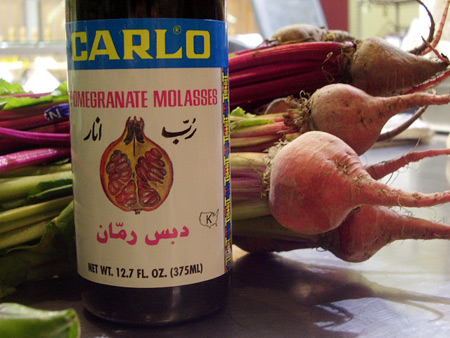Well, moving to San Francisco revealed that an Ivy League pedigree wasn't the only way to go. Beets that were roasted instead of boiled had a lush, jelly-like texture and a slight but alluring smokiness. When I discovered pomegranate molasses--a tart, intensely fruity syrup used throughout the Middle East and Central Asia, made made from the boiled-down juice of sour pomegranates--I knew I'd found my beets' soul mate.
Beets now star in two of my Jewish-holiday menus: as part of a thick, wintery borscht served alongside the Chanukah latkes, and in this blood-orange salad, always served for the Passover Seder in springtime It's not that there's a particular affinity between beets and Jews; it's just that, with a lot of guests on hand, I can count on more conversions.
This salad has flipped--for good!--many a self-avowed beet hater. Right now is a great time to try it, since both late-season blood oranges and early-season beets are available. Why blood oranges? Well, the beets are going to stain everything magenta anyway, so why not start with something that already matches? Also, there's a fruity-berry quality to blood oranges that matches the tart, almost winey flavor of the pomegranate molasses.
I've made this for my mother, and she likes it, well enough. But not as much as she still loves her Harvard beets.
Ruby Beet Salad
Adapted from The Astrology Cookbook: A Cosmic Guide to Feasts of Love, by Stephanie Rosenbaum.
Ingredients:
1 bunch beets (3 or 4 beets), unpeeled, stalks & leaves removed
2 oranges, preferably blood oranges
2 tbsp pomegranate molasses*, or to taste
1/4 cup olive oil
salt and freshly ground pepper
* You can find pomegranate molasses at Haig's Delicacies in San Francisco or at Indus Foods (1920 San Pablo Ave., Berkeley) in the East Bay.
Preparation:
Preheat oven to 350°F. Rinse beets and place them, still wet, on a square of aluminum foil. Fold the foil around them to make a nice little package. Pop in the oven and roast until you can slip a knife easily through both beets. If there's any resistance, let them roast some more; the more tender, the better. Remove beets from oven and let cool in packet. When beets are cool enough to handle, slip off skins. Cut into wedges and set aside.
Grate the rind off one of the oranges, tossing the grated rind with the beets. Cut the now-bald orange in half and squeeze the juice over the beets and rind. Drizzle on pomegranate molasses, olive oil, and salt and pepper to taste. Toss and taste for seasoning. Cover and refrigerate for at least 1 hour. Just before serving, peel and slice remaining orange and add to salad.
